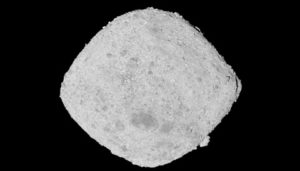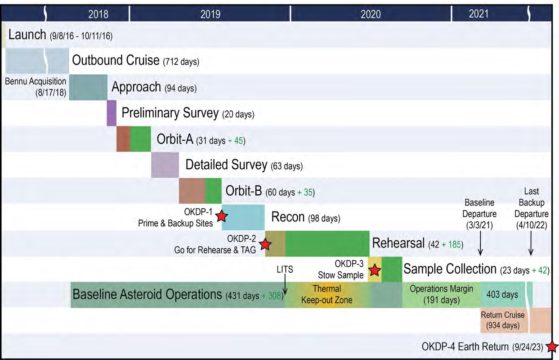NASA's ambitious Osiris-REX mission will now survey 101955 Bennu and attempt to return a sample to Earth.

NASA / GSFC / University of Arizona
A tiny new corner of the solar system is now open for exploration, as NASA's Osiris-REX (the Origins, Spectral Interpretation, Resource Identification, Security, Regolith Explorer) burned its engines for 20 seconds today for its arrival at asteroid Bennu. Acquisition of arrival signal occurred at 12:08 PM EST. Bennu is currently 7 light-minutes from Earth.
Welcome to Bennu
Osiris-REX isn't in orbit yet around tiny Bennu per se; a better description of its approach is a follow-along path keeping pace with the asteroid, a maneuver also known as station keeping. After a series of four engine burns starting in August 2018, Osiris-REX is now just over 12 miles (19 kilometers) from Bennu, with a relative approach speed to the asteroid of 0.10 mph (0.04 meters per second). In the coming weeks, the spacecraft will perform a series of polar flyovers of Bennu, passing 4 miles (7 kilometers) from the asteroid. Then, after a 20-day survey period, Osiris-REX will descend to just 2,400 feet (730 meters) above the asteroid's surface, for a preliminary mapping orbit around Bennu.
Launched from Cape Canaveral, Florida atop an Atlas V rocket on September 8, 2016, Osiris-REX made one Earth flyby on September 22, 2017, and took almost 26 months to finally catch up with asteroid Bennu. Osiris-REX also carried out a survey hunting for Earth-Trojan asteroids while enroute to Bennu, a search that came up empty. Osiris-REX's OCAMS camera suite started getting images of Bennu as a dot moving against the starry background just this past summer.
The LINEAR sky survey discovered the asteroid that would become known as Bennu (initially designated 1999 RQ36) on the night of September 11, 1999. The asteroid was later named during the Name That Asteroid! Contest after a mythical Egyptian bird. Orbiting the Sun once every 437 days, Bennu is 0.3 miles (0.5 kilometers) across, about the height of the Taipei 101 skyscraper. That is large enough to cause regional damage (but not global devastation) if it hits Earth on a future date.
In the 21st century, Bennu's closest approach to Earth will be 460,000 miles (740,000 kilometers) — just under twice the Earth-Moon distance — on September 23, 2060. Looking further ahead, Bennu's orbit does intersect the path of Earth, and the asteroid poses a slight impact risk of about 1 in 24,000 in 2175. During the subsequent 24-year timeframe from 2175 to 2199, a series of possible close approaches to Earth present a cumulative impact risk of 1 in 2,700. Orbits tend to get more chaotic over time, making it tough to predict the exact location of an asteroid centuries from now.
We've started getting good imagery of Bennu from the OCAMS camera suite aboard Osiris-REX over the past month, as the tiny world swells into view. Looking like a 10-sided die straight out of Dungeons and Dragons, Bennu actually shares an uncanny resemblance with asteroid 162173 Ryugu, where the Japanese Space Agency's Hayabusa-2 is currently carrying out a similar sample return mission. Bennu rotates once every 4.3 hours, and seems to have at several large boulders clustered in one hemisphere.

NASA GSFC / University of Arizona
What's Next for Osiris-REX
Now, NASA researchers plan to take it slow. Most of the next year is dedicated to scanning and mapping Bennu to select a landing site for sampling. Then, around July 2020, the real excitement begins, as Osiris-REX moves in for a series of touch-and-go sampling maneuvers.
"Now that we've arrived, we will explore [Bennu's] surface through a series of flybys and orbital campaigns that allow us to determine which areas on Bennu are the safest and have material that can be ingested by our sampling mechanism," says Daniella DellaGiustina (University of Arizona). "We'll do this first globally, and from there prioritize two candidate sample sites. We'll then examine those two sites at even higher resolution."
At about 30 meters (100 feet) from the surface of Bennu, Osiris-REX will go into a slow free fall in the feeble gravitational pull of the tiny asteroid. Osiris-REX will then raise its two solar panels into a Y-shaped configuration to avoid impacts from dust and debris or contamination during sample acquisition.

NASA / Osiris-REX / Dante Lauretta
Once the drum-shaped Touch And Go Sampling Mechanism (TAGSAM) contacts the surface, it will fire a burst of nitrogen gas at Bennu, stirring up debris into its collector. TAGSAM has enough nitrogen gas for three sampling attempts. Osiris-REX seeks to collect 60 grams of material (about the equivalent weight of an alkaline C battery) and although that may seem tiny, this sum will represent the largest sample return since the Soviet Luna 24 Moon mission in 1976, and the largest sample return from beyond the Moon. To date, the only other successful sample return missions were NASA's Stardust from Comet Wild 2, and JAXA's first Hayabusa mission to asteroid 25143 Itokawa, which returned a minuscule 1,500 grains (less than a milligram) of material.
Osiris-REX will depart Bennu in March 2021, and eject its sample return capsule for retrieval in the Utah Test and Training Range in September 2023.
Osiris-REX will also measure how asteroid Bennu tumbles and how its orbit evolves over time via a process of solar heating and thermal emission known as the YORP (Yarkovsky-O'Keefe-Radzievskii-Paddack) Effect. Bennu is a carbonaceous asteroid, and is thought to represent early solar system material in a pristine state. Scientists may be able to analyze the sample return and identify if asteroids such as Bennu delivered simple organic compounds and the basic building blocks of life to the early Earth.
"Sample return is vitally important for calibrating ground-truth comparisons of Earth-based telescope observations with the real sample in the laboratory," says Erin Morton (University of Arizona). "We don't know if near-Earth asteroids and meteorites that have collided with the Earth are truly representative of the entire asteroid population until we have more detailed data and samples from particular asteroids."
The sample return will be available for future generations to study and apply new analysis techniques. Also, it may prove useful to know just how well near-Earth asteroids are put together and what they're made of, in case we ever have to move one out of the way.
Get ready for the next exciting phase of exploration ahead for Osiris-REX at asteroid Bennu.
 2
2









Comments
John Sheff
December 4, 2018 at 3:40 pm
David,
Didn't Luna 24 return 170.1 grams from the lunar surface in 1976?
- John Sheff
You must be logged in to post a comment.
David DickinsonPost Author
December 5, 2018 at 4:04 am
Yup. Good catch... fixed!
You must be logged in to post a comment.
You must be logged in to post a comment.